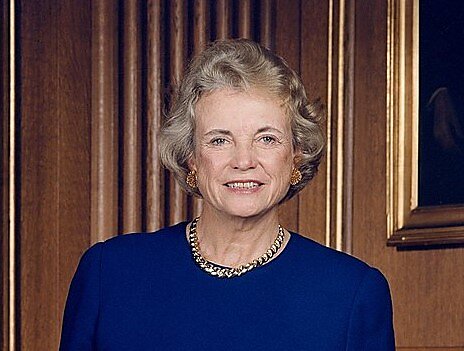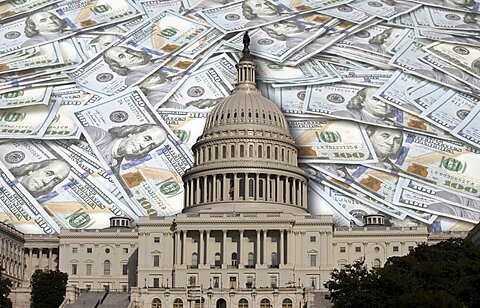My colleague Walter Olson has already written a lovely tribute to Justice Sandra Day O’Connor (1930–2023) discussing her judicial legacy. I write to add a few observations about her personal life, largely gleaned from Evan Thomas’s excellent biography, First. Justice O’Connor’s pragmatism and incrementalism made her unpopular with people who sought bolder decisions out of the swing vote (though Walter argues that some criticisms may be overblown). But those qualities may have been exactly what enabled her to often get her way.
Anyone who knows anything about Justice O’Connor knows she adored the Lazy B, the sprawling Arizona ranch on which she grew up. When asked what she would choose if forced to get a tattoo, she quickly responded that the choice was “easy.” It’d be “the Lazy B on [her] left hip.” Growing up on a ranch made her distinctly Southwestern: independent, self‐sufficient, tough but kind. She learned lessons about the harsh realities of nature and life early on. As Thomas notes in the biography, she learned to drive a truck “as soon as she could see over the dashboard” and had a hefty slate of daily responsibilities.
She was mentally tough but unafraid to be emotional. Her favorite books were “the Nancy Drew series, about a girl detective who wore skirts, was confident and curious, and who adored her powerful lawyer father.” Her fierce independence was not only required by her youth on the ranch, it was inherited from her dad. Harry Day (or D.A., as she called him) once remarked of FDR’s decision to institute Daylight Saving Time, “that son of a b**** even tells me when to get up in the morning and go to bed at night.”
She was a devoted public servant as much as a devoted wife and mother. She took off five years from her career to rear her children (even then, she stayed busier than ever volunteering). And she only left the bench once it was necessary for her to personally take care of her ailing husband John, who was descending into Alzheimer’s. She strikes me as the ultimate independent woman.
It’s often observed that Justice O’Connor didn’t have an overarching judicial philosophy. Personally, she favored better government, not necessarily less government. But that didn’t mean she wasn’t smart. She had a near‐photographic memory and was a speed reader. She received top grades at Stanford Law School, where she graduated alongside (and briefly dated) future Supreme Court Justice William Rehnquist. But being born a woman at that time meant she struggled to find a job until she finally secured a place in the county attorney’s office after volunteering to work for free.
She never felt sorry for herself, instead believing the anecdote for adversity was putting her head down and doing. (In fact, she was quite the doer. She would personally pour coffee for her clerk candidates. She waded into traffic jams and waived her arms at cars, directing them where to go. She took clerks on tough hikes without breaking a sweat.)
A few anecdotes are particularly telling. In 1988, Justice O’Connor was diagnosed with breast cancer that had spread to her lymph nodes. She returned to the bench ten days after surgery. Once, while giving a public speech soon after chemotherapy, she briefly left the stage, vomited, and returned to finish as if nothing had happened.
When her husband John, who had severe Alzheimer’s and was living in a nursing home, believed another Alzheimer’s patient to be his wife, Justice O’Connor remarked that she was happy to see her husband happy. She was the epitome of grace.
Justice O’Connor is well known as being a “first” (the first female Supreme Court justice, the first female majority leader of any state legislature), but that didn’t make her a revolutionary. She was supportive of women’s rights, but like everything, in moderation. Because of her style, she was never known as an activist the same way as Justice Ruth Bader Ginsburg was. Still, after (then‐attorney) RBG brought home Justice O’Connor’s opinion in Mississippi University for Women v. Hogan, Marty Ginsburg asked his wife, “Did you write this?”
O’Connor’s observation that the school’s women‐only policy “tends to perpetuate the stereotyped view of nursing as an exclusively woman’s job” was reminiscent of Ruth Bader Ginsburg’s comment that sex‐based laws keep women “not on a pedestal, but in a cage.” Later, after being assigned the majority opinion in United States v. Virginia (invalidating single‐sex education at the Virginia Military Institute), Justice O’Connor would hand over the honor of writing the opinion to RBG. That opinion would be one of Ginsburg’s triumphs.
Of course, there were differences between the two justices. Ruth Bader Ginsburg, for example, once acknowledged that men and women were different, but was careful to say that not all women were the same. Sandra O’Connor, by contrast, believed that there were almost no differences between men and women. Both, however, received more death threats at the court than any other justices.
As swing votes do, Justice O’Connor often earned the ire of both right and left. From a classical liberal perspective, her record is mixed but underappreciated. She joined the majority in Printz v. United States, an important federalism case, but wrote a concurrence noting the opinion’s limited holding. She similarly voted with the majority in Palazzolo v. Rhode Island, but wrote a concurring opinion that was decidedly less property rights friendly than Justice Scalia’s. Though she had originally upheld the anti‐sodomy law at issue in Bowers v. Hardwick, she later voted to overturn a similar law in Lawrence v. Texas. She was skeptical of racial preferences, (as in Croson v. City of Richmond, Adarand v. Pena, and others) observing that they were in some cases arbitrary and in others an outright political handout. But she refused to deem them outright unconstitutional, instead leaving the door open to future programs that were more carefully tailored. Ever the incrementalist, she wrote the opinion upholding racial preferences in Grutter v. Bollinger, with the caveat that, “We expect that 25 years from now, the use of racial preferences will no longer be necessary.”
Her dissents tended to be more vigorous. She wrote an excellent dissent in Kelo v. New London, disapproving of eminent domain (despite her earlier majority opinion in Midkiff v. Hawaii Housing Authority). She dissented in Vernonia School District v. Acton, which had upheld blanket drug testing of high school students as a condition of joining a sports team. And her dissent in South Dakota v. Dole is a triumphant defense of federalism.
Though her critics could be harsh, even her polar opposites on the bench found her endearing. Justice Thomas once said she was “the glue” of the Supreme Court, “the reason this place [is] civil.” On her departure from the bench, Justice Scalia wrote, “I have (despite my sometimes sharp dissents) always regarded you as a good friend—and indeed as the forger of the social bond that has kept the Court together. …Who will take that role when you are gone?” President Obama once asked a crowd, “Who does not love this woman?”
Justice O’Connor encouraged the justices to break bread with each other, believing you couldn’t stay mad at people if you shared a meal. She was a model of civility. Firm, but kind. And she’s a reminder to all that to be effective, one must not only be intelligent but also adept enough to get people to want to join you. That’s a lesson for all of us, whether on the bench, before the bench, or off of it.









